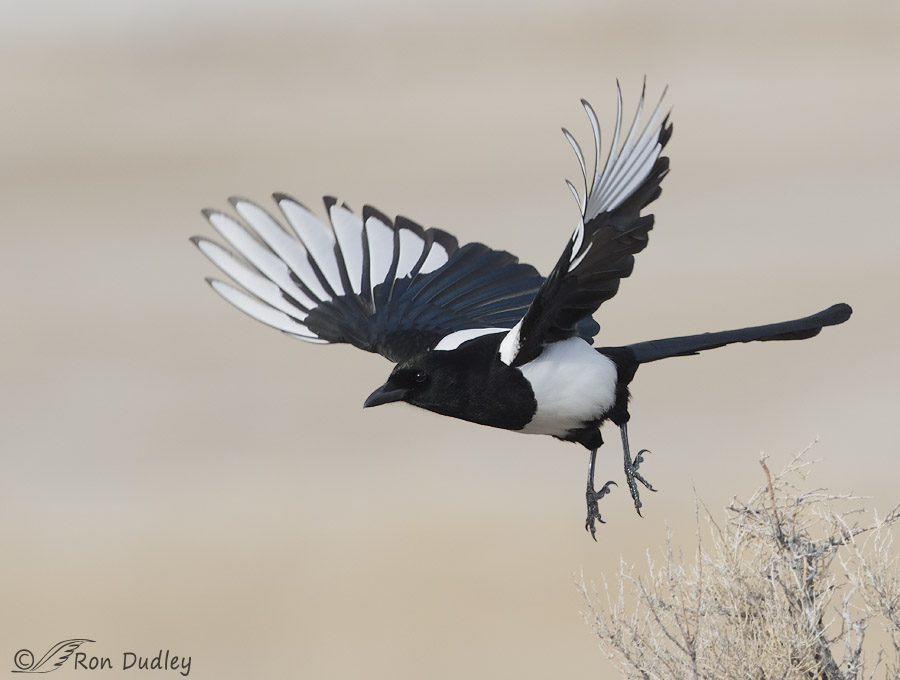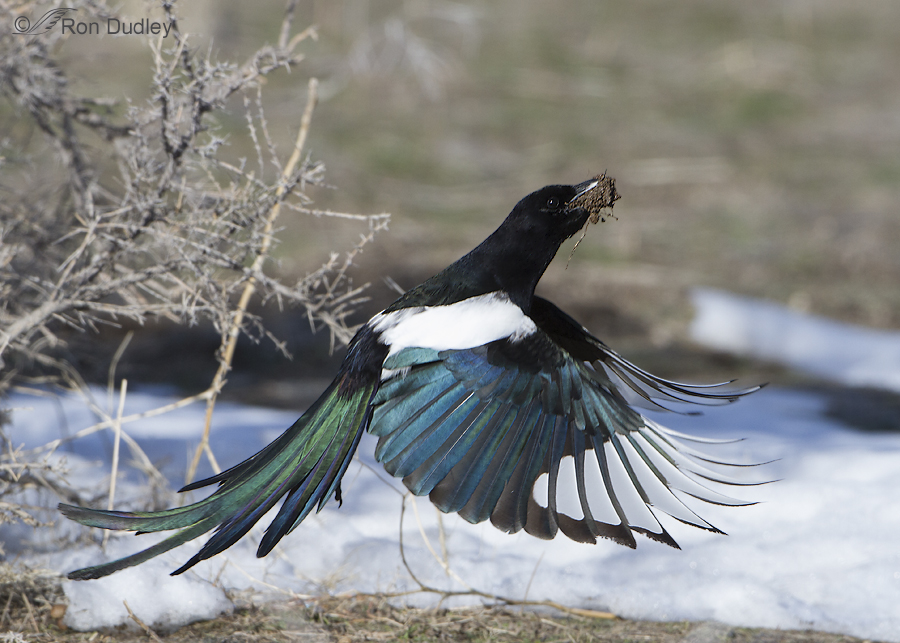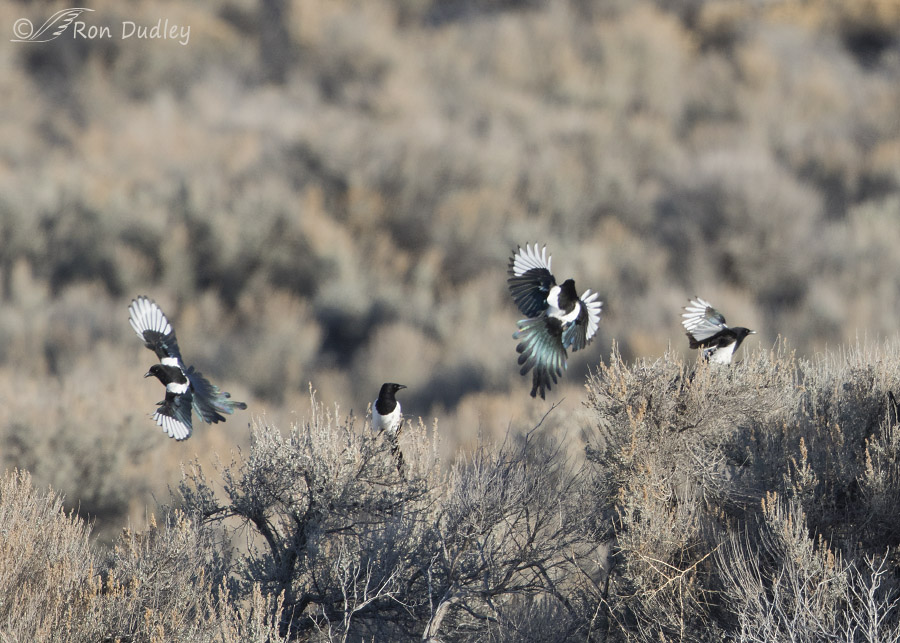I find it helpful to set photographic goals even though some of them may never be attained and only frustration results.

1/3200, f/6.3, ISO 800, Canon 7D Mark II, Canon EF500mm f/4L IS II USM, not baited, set up or called in
I’ve discussed the extreme variability in magpie iridescence on previous occasions. Typically the only colors we see in Black-billed Magpies are black and white. There are flashes of color but those colors are very transitory and more easily seen in photographs than with the naked eye. This magpie was taking off from a bush on Antelope Island earlier this month. I like the image but I’m always after iridescence and here we see only a hint of color in the blacks of the right wing. If the light angle is just right at the moment the shutter clicks you can get spectacular blues and greens in the tail and wings but here there’s almost none.

1/1600, f/7.1, ISO 500, Canon 7D, Canon EF500mm f/4L IS USM, not baited, set up or called in
In the past I’ve been able to get some nice color in a few magpie shots but not with the rear view with both wings and the tail flared that I’d like (this bird was hauling mud to the nest).
An incident three days ago on the island reminded me of what’s possible.
First a little background. I’m always on the lookout for large groups of magpies because such convocations often indicate the presence of predators like coyotes and Golden Eagles. As scavengers magpies hang around predator kills for obvious reasons. They also mob predators during the nesting season and magpies in this area have been building nests for weeks so watching magpies can lead me to other photographic subjects.

1/1600, f/6.3, ISO 640, Canon 7D Mark II, Canon EF500mm f/4L IS II USM +1.4 tc, not baited, set up or called in
These are four of about a dozen magpies that were screeching, squawking and flying about some sagebrush very far away from me but even at that great distance I had to stop and watch them through my lens to see what else might be going on. I never did see what was causing all the excitement but even at about an eighth of a mile away the photographer in me couldn’t resist firing off some shots for later analysis. The second bird from the right (and to a lesser degree the fourth bird from the right) reminded me of what is possible with magpies if everything comes together.
I’d love to have this shot of the second magpie from the right at a distance of about 75′ (with a head turn looking back at me of course). The tail colors and tail spread are spectacular and there’s even significant color in the wings. I think I’ve learned the angle of the sun to the bird that is most potentially productive for iridescent colors but then the magpie in flight must cooperate too and that combination doesn’t happen very often and I have to be close (and set up properly) when it does.
I may or may not ever succeed. But at least I know what to look for and that’s a start.
Ron


Truly a beautiful bird that you’ve captured in the most amazing ways.
Wow. An explosion of color! I can’t wait to see more.
So many wonderful nuggets of knowledge in your posts. (I was going to use “gems” but that analogy was recently used elsewhere ….)
1. Set goals.
2. Consider overall light.
3. Think about the subject, its color balance and contrast.
4. Know how the angle of the light source will affect the shot to produce the desired effect.
5. Understand your subject’s nature and what its behavior may indicate (e.g., excited magpies may mean predators present).
6. Have the right equipment pre-set to achieve your goal.
7. Practice, practice, practice.
All of this plus superb images to motivate those of us who are still struggling with all of the above.
Thank you again, Ron!
Wow, I didn’t know I said so many things in this post, Wally, but I guess you’re right. Thanks a lot.
Being from the east the first time we saw the Magpies we were very excited. At the time we didn’t realize that the locals consider them “pests”. But they certainly did bring a sense of awe to us with their amazing colors. They are like our starlings. Beautiful to look at, but can be a backyard pest. Beautiful photos.
Sue, True, some of us westerners think of them as pests but not all of us, not by a long shot. IMO, the world would be poorer without magpies. Thank you.
A visual feast of Magpies…BEAUTIFUL!!!! I LOVE them all. Incredible iridescence…would sure like to see a close up version of that second from the right bird and the far left one. Photography is certainly loaded with teasers!!!
“would sure like to see a close up version of that second from the right bird”.
So would I, Patty. I’ll be working on it. I tried again this morning but once again it didn’t happen…
WOW! These are wonderful shots. I’ve mostly ignored Magpies…not any more. Another great lesson…thanks Ron!
I ignored them for much too long myself, Jerry. I love them as photographic subjects, challenges and all.
Ron, these are simply amazing. You have not only captured the magnificent colors of magpies, but there wonderfully outrageous personalities. I mess around with drawing birds using colored pencils, and that irridecent turquoise is nearly impossible to capture, as is the personality of these birds. But like you I have a goal to one day get it. Do you mind if I use one of these photos as a model for drawing?
And thanks for your daily photos of birds and wildlife. I can’t tell you how much I look forward to seeing what you’ve managed each day. Cathryn
Thanks very much, Cathryn. I’ll email you regarding your question.
Spectacular, Ron … truly spectacular!!!
Thank you, Lois.
Absolutely stunning Ron!
Thanks, Nancy.